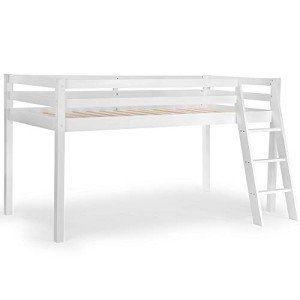A Comprehensive Guide to Children's Bunk Beds: Styles, Benefits, and Safety Considerations
Bunk beds have ended up being a popular option for families seeking to make the most of space and supply an enjoyable sleeping environment for kids. With their unique style, they provide an innovative and practical option for shared bed rooms, playrooms, and even guest lodging. Bunk Beds Cheap out the numerous styles of children's bunk beds, their advantages, safety factors to consider, and answers some regularly asked concerns.
The Allure of Bunk Beds
Kid's bunk beds are more than simply space-saving structures; they are also a gateway to daring dreams and imaginative play. Below is a detailed examination of their many benefits.
Advantages of Bunk Beds
- Space-Saving: Bunk beds efficiently use vertical space, making them a perfect option for smaller spaces.
- Playful Design: Many bunk bed designs consist of slides, camping tents, and themed aspects, stimulating creativity and enjoyment.
- Partner Sharing: Bunk beds are ideal for siblings sharing a space or accommodating slumber parties.
- Versatile Use: Some designs can be separated into 2 individual beds, offering flexibility as kids grow.
- Storage Options: Many bunk beds feature integrated drawer storage or shelves, further enhancing their usefulness.
Designs of Children's Bunk Beds
The variety of bunk beds available today deals with different choices and needs. Below is an overview of some popular designs.
| Style | Description | Best For |
|---|---|---|
| Requirement Bunk Bed | A standard design including one bed stacked above another. | Siblings sharing a space. |
| Loft Bed | Similar to a bunk bed without the bottom bunk, permits a workspace or play location listed below. | Restricted space for play/desk. |
| L-Shaped Bunk Bed | 2 beds set up in an L-shape, often with additional areas for storage or play. | Unique room designs. |
| Twin Over Full | A twin bed over a complete bed, accommodating various sleep requirements. | Growing kids and teens. |
| High Sleeper | Stands even greater than a loft bed, normally including a desk or play location below. | Older kids needing more play/desk space. |
| Tent Bunk Bed | Bunk beds with a canopy or tent-like structure, producing a relaxing, enjoyable space. | Active and creative children. |
Secret Features to Consider
When picking the ideal bunk bed for kids, the following functions are worth considering:
- Material: Bunk beds can be made from wood, metal, or a mix. Each has its unique visual and toughness.
- Weight Capacity: Always verify the weight limit of the bunk bed to guarantee it can accommodate your kids safely.
- Safety Rails: Ensure the top bunk has durable rails to avoid falls.
- Ladder Security: A well-designed ladder needs to offer simple and safe access to the upper bunk.
- Ending up: Ensure any surfaces are non-toxic and safe for kids.
Safety Considerations
Safety is critical when it pertains to kids's bunk beds. The following standards ought to be abided by:
- Age Appropriateness: Generally, kids under 6 years of ages ought to not sleep in the upper bunk due to safety risks.
- Strong Construction: Ensure the frame and materials are strong and can support the weight without drooping.
- Routine Maintenance: Periodically look for loose screws, bolts, or other components that may need tightening.
- Clear Play Area: Keep the area around the bunk bed without toys and challenges to lessen tripping threats.
Setting Rules for Safe Use
Establishing standards for bunk bed use will assist guarantee security:
- Limit Jumping and Climbing: Children ought to be advised versus leaping from the top bunk and climbing up on the sides.
- Monitoring Sleepovers: Monitor young guests while they are utilizing the bunk bed for the very first time.
- Inform on Ladder Use: Teach how to utilize the ladder securely, highlighting the value of dealing with the ladder when climbing or down.
Often Asked Questions
1. What age is proper for a kid to oversleep the leading bunk?
Most makers advise that kids should be at least 6 years old to oversleep the upper bunk. This guideline is created to mitigate the threat of falls.
2. Can bunk beds be tailored?
Yes, lots of manufacturers offer personalized options, including colors, materials, and additional functions like drawers or desks.
3. Are bunk beds safe for weight?
Bunk beds have weight limits, usually varying from 200 to 400 pounds, depending upon the model and product. Constantly check the maker's specs.
4. How do I preserve and clean up a bunk bed?
Routinely look for loose parts, keep the bed clean by cleaning down surfaces, and make sure the bedding is fresh to promote a safe and sanitary sleep environment.
5. Can bunk beds be separated into individual beds?
Lots of bunk beds include a choice to separate them into 2 individual beds, supplying long-lasting adaptability.
Children's bunk beds are more than mere furnishings; they are a practical, versatile, and creative part of a child's space. With different styles readily available and various safety factors to consider to keep in mind, moms and dads can choose the perfect bed that fits their space, fulfills their children's needs, and imparts a sense of experience. By comprehending the benefits, designs, and precaution connected with bunk beds, families can create a wonderful and safe sleeping environment for their kids. Whether for siblings sharing a room or space-saving options, bunk beds remain a beloved choice for numerous families.

